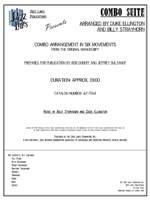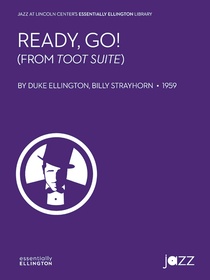COMBO SUITE
Arranged by Duke Ellington and Billy Strayhorn, Prepared by Dylan Canterbury, Rob DuBoff, and Jeffrey Sultanof

Cat #: JLP-7564
$100.00This item usually ships within 1 business day.
Questions?
Please call +1-518-587-1102 or email us.
Edition: Jazz Combo Arrangement
Description: Swing - Medium
Publisher: Jazz Lines Publications
It's no secret that the end of the big band craze left many a notable bandleader struggling to make ends meet from the mid-1940s on. Even Duke Ellington was no exception to this rule, at times only able to keep his bands afloat due to a steady stream of royalties from his many compositions. During these lean times, Ellington would occasionally form combos of his sidemen to bring into the studio. These combo recordings were mostly kept private until after Ellington's passing in 1974 and served as a quick paycheck for the otherwise underemployed musicians. This suite of six relatively obscure Ellington/Strayhorn compositions (originally strung together under the title "Hi-Fi-Fo-Fum") was recorded in 1967, but was not released to the public until 1986.
The band on this recording was Johnny Hodges on alto sax, Paul Gonsalves on tenor sax, Harry Carney on baritone sax, Cat Anderson on trumpet (who employs a plunger mute through the entire suite), Lawrence Brown on trombone, Ellington on piano, John Lamb on bass, and Rufus Jones on drums. Most of the original manuscripts were simple lead sheets, but this version has been reconstructed to mimic the solo orders, unwritten backgrounds, etc. of the original recording.
Movement 1: "Intimacy Of The Blues"
Recorded by the full Ellington band around the same time for the Strayhorn tribute album "...and his mother called him Bill," this movement is easily the best known tune of the suite. Its simple but highly catchy melody and steadily rollicking groove make it an ideal way to start things off. The soloists on the recording are Hodges and Brown, with some likely improvised backgrounds behind each. An optional ending has been included to allow for live performances to avoid attempting the booth fade out of the original recording.
Movement 2: "Out South"
A plucky Ellington piano introduction leads into a melody that, while similar in tempo and feel to the previous movement, is a bit more gospel influenced and earthier sounding. Once again, Brown and Hodges are the primary soloists, swapping turns on the A sections and bridge of the 32 bar form for each chorus. The melody is stated twice, serving double duty as a background figure for the soloists.
Movement 3: "Tell Me 'Bout My Baby"
This movement sees the ensemble shift away from a swing feel to a Latin groove. The tune follows a standard AABA form with a twist in the form of 10 bar A sections. Like the previous movement, the melody also serves as solo backgrounds throughout. The soloists this time are Hodges once again and Anderson. The arrangement ends with two extended vamps, one for each soloist. Anderson plays a brief solo cadenza before Ellington chimes in with two ominous chords to finish things up.
Movement 4: "Kentucky Ave, CA"
The band returns to the blues for this movement, this time in Db as opposed to Eb as before. Ellington plays an 8 bar introduction to set up a melody that can best be described as bare bones - it's clear the main goal here is to just bide time until the solos can begin. Hodges yet again kicks things off with the first solo chorus, followed by a chorus apiece from Brown, Anderson and Gonsalves. On the latter two's choruses, Hodges and Brown play a simple impromptu background. The melody is played 4 times at the end, with Hodges soloing over the top of the ensemble for the 2nd time on. A brief generic bass break sets up Ellington's final piano clank.
Movement 5: "Near North"
Easily the brightest tempo of the suite, the band launches into the simple but brisk melody right away. This movement serves as a vehicle for Gonsalves, whose bop leanings are perfect for this setting. Gonsalves plays three choruses, with some simple backgrounds from the other horns on his first and third choruses. The melody is never repeated in full, with the ending being a single A section. Gonsalves takes an extended solo cadenza prior to the band's final dissonant chord.
Movement 6: "Soul Country"
A chunky Ellington piano introduction sets up what is otherwise a rather graceful melody that has some shades of "Mood Indigo" at times. The groove returns to a Latin feel, albeit quite a bit more relaxed than before. The melody once again serves as a background for solos as well. The soloists on this final movement are Brown and Hodges. After a four bar introduction recap from Ellington, the horns play one final ascending line that leads into the warm last chord to bring the suite to a satisfying conclusion.
This arrangement is for jazz octet. It has been prepared from Ellington and Strayhorn's original sketch score and the set of parts used during the recording session. In addition, some sections were transcribed from the recording.
Alto Saxophone
Tenor Saxophone
Baritone Saxophone
Trumpet
Trombone
Piano
Bass
Drums







![HALF THE FUN [FROM SUCH SWEET THUNDER SUITE] View: HALF THE FUN [FROM SUCH SWEET THUNDER SUITE]](https://www.ejazzlines.com/wp-images/product/thumbnail/jlc5145.jpg)




